- Home
- Ian McDonald
Scissors Cut Paper Wrap Stone Page 2
Scissors Cut Paper Wrap Stone Read online
Page 2
After showering and freshening up, we dine with the priest’s young family. His two sons, ten and twelve, are politely gobsmacked to be in the presence of the creator of Danjuro 19: Kabukiman! I am certain that the smartplastic anime slips Mas presents to them will be as enshrined and treasured as the Daishi’s images of Kannon. After tea, Mrs. Mizuno announces that our baths are ready. As I have been expecting. As I have been dreading. On the pretext of blisters I return to our room and hunt for the synthflesh. For one heart-stopping moment I cannot find it among socks underwear shorts teeshirts weather-proofs, then my fingers close around its stubby, comforting cylinder. This product dries to a flexible, porous, smooth finish in fifteen seconds, say Hoffmann Helvetica Chemie Ag. Eyes firmly shut, I slip off my left glove, feel cool spray in the palm of my hand. I give it a double dose, just to be sure. Thirteen hippopotamus fourteen hippopotamus fifteen hippopotamus. Quick glance to make sure I am alone, then I close my eyes again, repeat the procedure for the right hand and go to join Mas and Mizuno, who, it transpires, is an old Soul fan. Up to our chests in hot, tangerine-scented water, we holler out Motown, Atlantic, and Stax classics in creaky three-part harmony. Mrs. Mizuno says it is the funniest thing she has heard in weeks.
The henro lodge is cool and airy, filled with the sounds and scents of late spring in the Yoshino Valley. Sleep is easily found in such a room: within seconds I have tumbled into the slumber of the righteous.
When the cry wakes me I cannot think where I am for one hideous instant. I find my fingers tearing at the scab of artificial flesh in the palm of my right hand. No. No. Namu Daishi Henjo; I fight the demons with the weapons of a good pilgrim. And it passes.
Masahiko is bolt upright in his bed, eyes wide, body rigid, trembling. I can see that he is deep, far below the surface of his subconscious.
“Mas…” Kneeling before him, I touch his shoulder, gently.
“No! No!” he shouts. “Leave her alone!”
“Mas?”
No answer.
“Mas…”
No answer. I sit with him until whatever storm has troubled him has passed and he has settled back into sleep. I join him, we two, pilgrims together, and sleep without any further dreams until dawn.
THE DAY IS WARM and bright as we splash across the gravel bed of the Yoshino River and follow the old henro path into the hill country. At Temple Ten valley Buddhism ends, mountain Buddhism begins. Zen is the spirit of the valleys, Shingon the spirit of the mountaintop. And as the spirit of Zen is different from the spirit of Shingon, so the sunlight and warmth of the valley give way to the more testing weather of the mountains. Gray wads of cloud move in from the west; within an hour it is raining steadily. Rain and mud, the henro’s twin curses. Our legs are spattered with it, the bikes are caked with it, and our hands and faces are numb from cold rain. Rain sheets from our plastic capes and pilgrim hats. The way is steep and treacherous—bottom gear for an hour, with many portages. All head-on into wind and driving rain. Concentration is total. Misery absolute. Temple Eleven is deserted, derelict, decaying, vandalized by akiras. Among their graffiti, their beer cans, we find the remains of cooking fires, silver foil sachets of camping ready meals, condoms, needles, rotting biomotors and batteries, empty cartridges.
“I don’t like this,” says Mas, clearly spooked. Pigeons explode from beneath the eaves of the ruined Daishi Hall. Some, I notice, have parasitical zoomorphs clinging to their bodies. Reading it for an ill omen, we press on.
From Eleven to Twelve is half a day’s ride past two bangai—unnumbered temples on the pilgrimage route that are not Sacred Sites. Both, like Eleven, are deserted and desecrated. On. Uphill all the way. I find my mind withdrawing, shutting out the sensual world and its insistencies, drawing veils of memory. I am no longer conscious of the cold and rain, the ache in my thighs. I remember.
I remember his life.
I call him “he” because, though he shared the same face, the same name, the same body and mind as I, he is dead. Unarguably. Indisputably. Dead. He was killed. Not with bullets or knives or monomolecular wire in an alley in some anonymous central European city, not with drugs or poisons. He was killed with guilt. What survived him, this thing pushing its gaudily colored MTB up the side of a Japanese mountain, is only the slag. Only the ashes.
I remember…
ON THE DAY THAT Ethan Ring was conceived, West Germany won the World Cup to the refrain of Luciano Pavarotti singing Nessun Dormas as Nikki Ring, twenty-something, unemployed, unemployable, engaged in five minutes of intense coitus in South Mimms Services car park off the M25 with a Dutch truck driver hauling a consignment of salad vegetables.
On the day that Ethan Ring was born an armor-piercing smartbomb hit an underground shelter in Baghdad and incinerated five hundred men, women, and children while Bette Midler sang about God watching us from a distance.
On the day that Ethan Ring kissed his first girl—Roberta Cunningham at the back of Miss MacConkey’s P2 class—Europe very quietly, very unremarkably, without any embarrassing mess or fuss or anyone noticing, united.
On the day that Ethan Ring took his first date, Ange Elliot, age thirteen, to the local Pizza Hut for a double-cheese, diet Coke, and under-the-table footsie, Doctors ten Boom and Huitsdorp of the new, respectable, fully integrated, and racially harmonious South Africa won the Nobel prize for biology in recognition of their work on designing an artificial organism that converted sugars into useful electricity—to layman Ethan and his contemporaries, a living battery.
Too tall too early, red hair—too much of it—socially crippled by acne and self-consciousness, Ethan Ring would almost certainly have grown into neurotic teenhood but for the shelter, succor, and support of the Nineteenth House kinship. From the moral ruins of the HIV-haunted nineties, strewn with the desiccated bones of broken relationships, a new sociological order had emerged of clusters of single women—separated, widowed, divorced, never partnered—joined together under a common roof against a sea of free-floating males. The kinship: average size five point three: three point two generating the income to support themselves and the average two point one career mothers who parented the children. Men come, men go at the individual partners’ discretions, but are never considered part of the family unit. 2003: the kinship achieves legal recognition in the European courts. 2012: one third of all permanent relationships are kinships. 2013, early May: Nikki Ring joins the Nineteenth House gaining a telecommuting designer of European farming magazines, a home-delivery sandwich Empress, a jewelry maker, a co-mother who has retired thankfully into parenthood out of Futures, two new daughters, one new son, a condominium on the South Coast (the eponymous Nineteenth House) with sun terrace and shared swimming pool, peace, stability, love, security; contributing: Ethan Ring. Ethan Ring gained roots; he whose prior experience of the New Europe had been Doppler blur of tail-lights punctuated by ten thousand radio jingles and the smell of scorched sunflower oil in a nation of bed’n’breakfast rooms. The fertile ground of the kinship germinated a long-dormant talent for visualization, for seeing ideas projected on the backs of his eyeballs and making them seeable to others. Nurtured by his ex-Futures co-mother, his talent took him through and out of Michael Heseltine Comprehensive to art college in some rainy day city in the north to study Graphic Communications. He suffered agonies of acclimatization and socialization. He contemplated leaving. He contemplated a bottle and a half of paracetamol. He found friends in time: a Japanese exchange student with a dark and secret passion for comic-book animation; a dark-haired computer junkie from the North Country who taught Ethan the necessary skills of drinking rolling joints pulling girls; his girlfriend, a fellow Graphic Communications student who looked as if her name should end with a “y” but in fact didn’t.
On the day that Ethan Ring met Luka Casipriadin, Leconte Bio in Lyons discovered a technique for loading human memories, emotions, and experiences from an implanted bioprocessor onto a mainframe AI template to create an interactive simulacrum of the dead. The
first immortal since ancient Greece came from Santa Rose, CA, had Made It in sugar beet, but couldn’t beat the carcinoma. Her persona was alone three years in cybernetic heaven before anyone could afford to join her.
Somebody had stolen Ethan Ring’s shopping. He had gone back to lock up his rustbucket of a Ford and the bags were gone from outside his first-floor flat. Life in the rainy-day city had made him stoical: microwave TVchow-4-Is made him fat and gave him wind anyway. The next day there was a knock at his door. On the landing was the girl from first-year Fine Arts you could not help noticing because she had shaved her head except for a crest of black hair that flopped into her eyes all the time.
“You could at least have made some effort.”
“Pardon?”
“Knocked a few doors. Made a few routine inquiries. You could have tried a little.”
“I’m sorry. Are you sure you’ve got the right flat?”
“Okay okay, I admit it. I took your food. Me. Luka Casipriadin. I live upstairs from you. You didn’t know. Ah. It’s Georgian, originally. Casipriadin. So my father says. Can I come in?”
“You took my food? Why did you take my food?”
But she was already sitting on his curry-and-beer-stained sofa scrutinizing with the eye of first-year Fine Arts his soft-porn posters of airbrushed cyber-girls with chromium breasts. Shit shit shit piles of dirty underwear Chinese food cartons beer cans.
“One life furnished in early squalor. You know you are what you eat?”
“Unh?”
“I’m beginning to think maybe I made a mistake with you. Syllogismic logic: if I am what I eat, and you are what you eat, then if I eat what you eat, therefore I should become you.”
“So you ate my food.”
“And got fat and farted a lot.”
“Why…”
“Because you have fabulous hair I would kill for. Because you were never going to talk to me, so I had to get to talk to you. You hungry? Of course you are. I ate all your food. Come up to my place. I’ve got stuff on.”
“My stuff?”
“My stuff. Eat my food, be me. You have a name?”
“Ethan Ring.”
“Oh, classic name. I knew I hadn’t made a mistake with you.”
FROM THE PERSPECTIVE OF A fluorescent speck clinging to a mountainside in Shikoku, I am able to tell her that she had, she did, a small mistake, a misjudgment of character, that would slowly, gradually, destroy entire lives. Sensitive dependence on initial conditions; one word, one act, can change the world. Well they named it chaos theory.
From the perspective of the pilgrim, this mountain land is exhilarating; the swoop from the mountaintop temples down the sheer henro path is thrilling, madly reckless. There is a great spirit in high country. Shinto peopled the peaks with ancestors and kami but clung to the valleys; Buddhism took its temples to the very mountaintops and opened the numinous to the people of the valleys. The legends attached to Shikoku’s high places gives an indication of the power of the spirit of the mountains in the Japanese psyche.
A hundred years before Kobo Daishi, En the Ascetic, an early Buddhist missionary, bound a fire-breathing dragon that had been ravaging the farms and livelihoods of the people below beneath a stone on the hilltop where Temple Twelve now stands—the temple to which we are traveling along forest trails and firebreaks. Inspired by the Buddha, the boy Daishi went up to the mountain peaks above the valley of his birth—a subtemple of Temple Seventy-five commemorates the spot—and leapt from the summit, crying out, “If I am to be the people’s savior, then save me, O Buddha! If not, then let me perish!” Naturally, Buddha erred on the side of mercy. To me the most meaningful legend of mountain Buddhism is that of Emon Saburo; a rich and oppressive landlord from Ehime Prefecture (a valley man, short in spirit) who shat in the begging bowl of a wandering priest—the Daishi in disguise—and thus earned the Job-like curse of losing family, friends, and fortune in a single night. Smitten by conscience, he gave all his lands to his tenants and set off in pursuit of the Daishi to beg forgiveness. But however strenuously he pursued the saint, he was never able to catch up with him. After four years and twenty circuits, he was struck by the idea that he would stand a better chance of meeting the Daishi if he reversed the direction of his pilgrimage and so met him coming. On his twenty-first circuit of Shikoku he came, near to death with cold and exhaustion, to a mountaintop. The Daishi appeared to him and absolved him of his sins. Before dying, Emon Saburo requested that he might be reborn as the lord of his home province—then Iyo, now known as Ehime—so that he might do mighty works of good to atone for his evil deeds in this life. The Daishi picked up a small stone, wrote Saburo’s name on it, and pressed it into his hand. Then Emon Saburo died and the Daishi buried him and changed his pilgrim staff into a cedar.
Like all good stories, there is a twist in the tale. Late the next summer, the wife of the Lord of Iyo gave birth to a son; fine, healthy, beautiful, except that his left hand was clenched shut and could not be opened. A Shingon priest was summoned, who prayed and invoked the name of the Daishi over the boy. Slowly, his fist relaxed, and opened. Inside was a small stone. On the stone were written the words “Emon Saburo Reborn.”
Namu Daishi Henjo Kongo!
We ride up the long, shallow steps to Temple Twelve. No priest here, nor any pilgrims; we share the mountainside forest clearing with a handful of industrial robots marked with the ciphers and seals of Tokushima Prefecture Bureau of Antiquities. Beyond Twelve the gray weather breaks. Unfaltering sunshine lights our way and we go ridgerunning across the tops of the valleys and down the mountain paths. Light has always made me feel reborn. I want to do this forever.
Temple Thirteen—Dainichi-ji—is sited on a coll at the head of a valley of big, prosperous farmhouses set like scattered islands in a sea of gently undulating sugarcane and bamboo. Like Twelve, it has fallen from grace, staffed also with stolid robots in the employ of the Bureau of Antiquities. Prayers in an empty hall; a computer stamps our albums. As we click into our toe clips, lean into handlebars, a Nissan biopower pickup pulls up outside the gate in a crunch of damp gravel. A middle-aged woman with startling fluorescent green rubber boots leaps out and greets us warmly. Her name is Mrs. Morikawa. She owns a farm ten kays down the valley, but is also the official curator (part-time) of Buddhist Cultural Heritage Sites Twelve—Fifteen. Her monitors flagged her that there were henro working their way along the old pilgrim path: we are the first in three years to have followed the Daishi’s Way, would we do her the honor of staying the night as guests in her farmhouse?
We consider her offer of settai. The afternoon is almost gone. Temples Fourteen and Fifteen are eight kays distant over heavy terrain. Mas has booked us into a drab tourist motel just outside Tokushima on the main interprovincial highway. Waiting is a warm farmhouse, country food, clean beds, hot water.
The bikes go in the back, we squeeze into the front beside Mrs. Morikawa. Gunge-tacked to the dash is a mass-produced plastic statue of the Daishi in henro robes. Dogyo Ninin.
As we drive through the cane plantations and bamboo, Mrs. Morikawa confesses an ulterior motive behind her gift of hospitality. Her eldest daughter is sick with an unnamed wasting disease. The doctors and their robots have offered the most advanced medical science but they admit that sicknesses such as these are as much of the spirit as of the body. She wonders: could we, would we, see her daughter? Ancient belief credits great power to the temple seals inscribed in henro albums; Mrs. Morikawa and her mother before her saw great acts of healing when pilgrims passed their albums over the bodies of the sick. Mas protests: we are not faith healers, miracle workers, shamen, hijiri—itinerant Buddhist holy men—we are spiritual seekers sinful as any men. We do not emulate the Daishi, merely follow his way. The woman pleads—it can do no harm. Indeed, it cannot, nor any good, if it is only a matter of calligraphy passed over a sick spirit. But I feel, I know, that it may be more. Must be more. Demons and Daishis are jealous masters where spirits are at stake. Wind
stirs the tall bamboo and in the space of a few sentences the dirt road with its twists and turns has become the entrance to a moral trap so intricate, so labyrinthine, I am its captive before I am aware I have entered.
“We will do it,” I say, cutting Mas’s protests short. Mrs. Morikawa is overjoyed.
Grass roof sloping nearly to the ground, satellite dishes, comlinks, shit digesters, methane plants, syrup tanks, agricultural robots: a typical twenty-first-century Japanese country manor. A son leaves off easing the dead biomotor out of a roboplanter to store the bikes in the barn. Halfway to the house something hits me a huge, soft thump in the back. As I go sprawling on the concrete the woman picks up a black, flapping something, shouts at it, throws it away from her. With a scream of indignation, it scuttles into the barn.
A glider cat.
The woman apologizes. They recently bought a franchise. Now every time anyone calls at the house, they come swooping down from high vantages on the webs of furred skin between their fore and hind legs to investigate. As she opens the door, a black ball of fur crouched above the porch opens moon-yellow eyes and regards us balefully.
The smell of death in the sick girl’s room is so strong as to be almost overpowering. It is not easily learned, but once you have the stink of it, it never quite leaves you. I cling to the door frame to steady myself.
“Won’t eat, won’t talk, won’t let anyone help her, won’t do anything but lie in her bed and swallow pills,” says Mrs. Morikawa in the voice of a woman so accustomed to pain it has become an intimate friend.
The girl is fifteen, sixteen, the age it likes its victims best. Anorexia, bulimia, cognitive metabolic disorder; they have found new names and faces for it but at its heart its name has always been self-loathing, its face, self-destruction. The doctor who called it a disease of the spirit advised well. Mas swears quietly, reverently in English.

 Empire Dreams
Empire Dreams The Menace from Farside
The Menace from Farside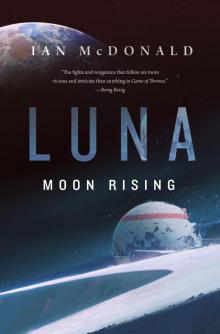 Luna: Moon Rising
Luna: Moon Rising Moon Rising
Moon Rising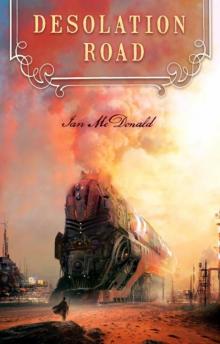 Desolation Road dru-1
Desolation Road dru-1 Empress of the Sun
Empress of the Sun Ares Express dru-2
Ares Express dru-2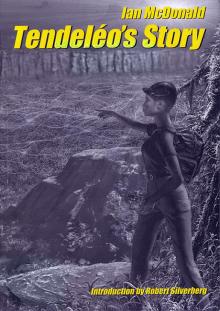 Tendeléo’s Story
Tendeléo’s Story River Of Gods
River Of Gods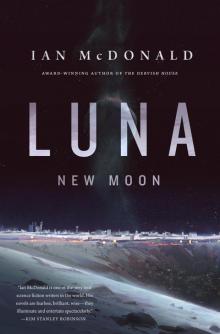 Luna
Luna![Cyberabad Days - [River of Gods 02] Read online](http://i1.bookreadfree.com/i1/03/29/cyberabad_days_-_river_of_gods_02_preview.jpg) Cyberabad Days - [River of Gods 02]
Cyberabad Days - [River of Gods 02] Clarkesworld Magazine Issue 76
Clarkesworld Magazine Issue 76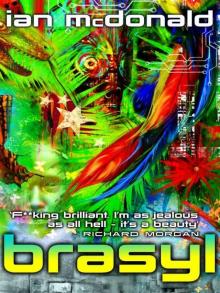 Brasyl (GollanczF.)
Brasyl (GollanczF.)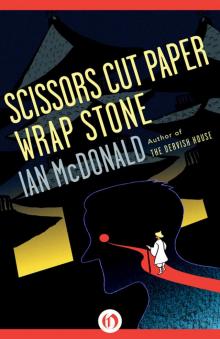 Scissors Cut Paper Wrap Stone
Scissors Cut Paper Wrap Stone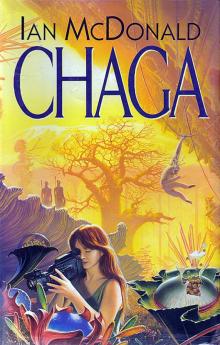 Chaga
Chaga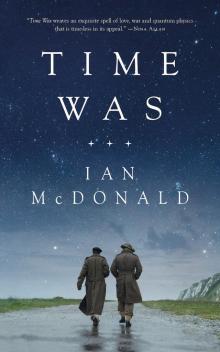 Time Was
Time Was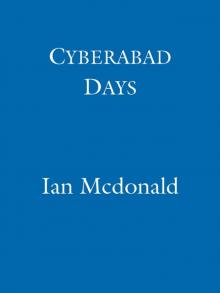 Cyberabad Days
Cyberabad Days Be My Enemy
Be My Enemy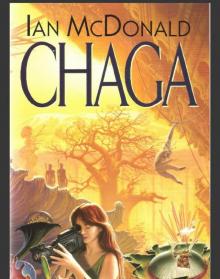 Changa
Changa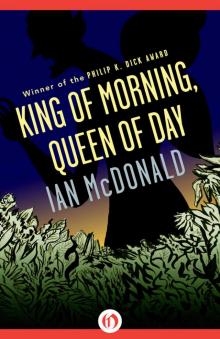 King of Morning, Queen of Day
King of Morning, Queen of Day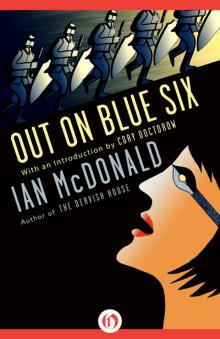 Out on Blue Six
Out on Blue Six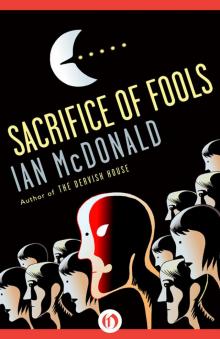 Sacrifice of Fools
Sacrifice of Fools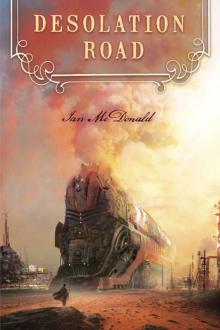 Desolation Road
Desolation Road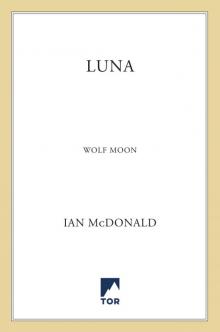 Luna--Wolf Moon--A Novel
Luna--Wolf Moon--A Novel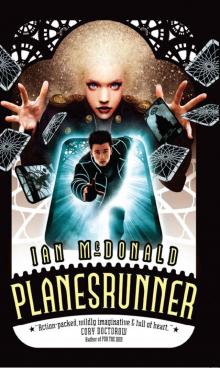 Planesrunner (Everness Book One)
Planesrunner (Everness Book One) Ares Express
Ares Express